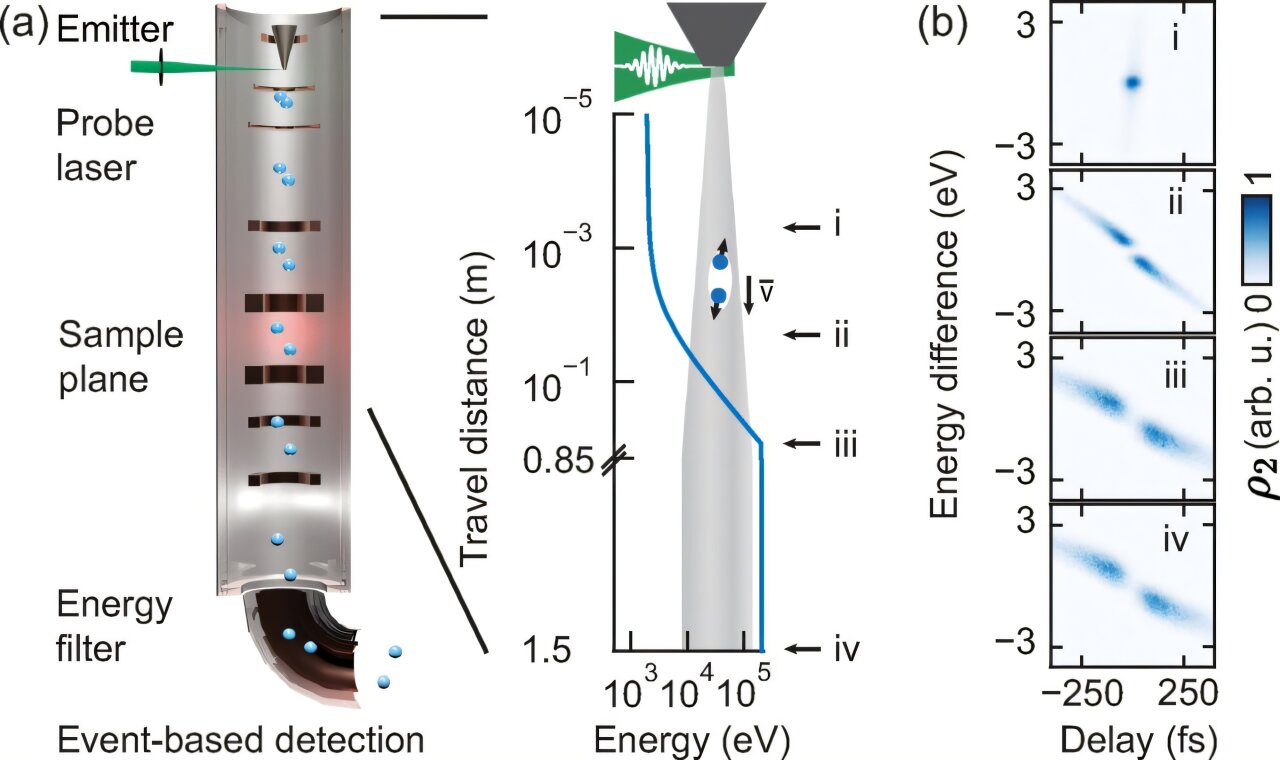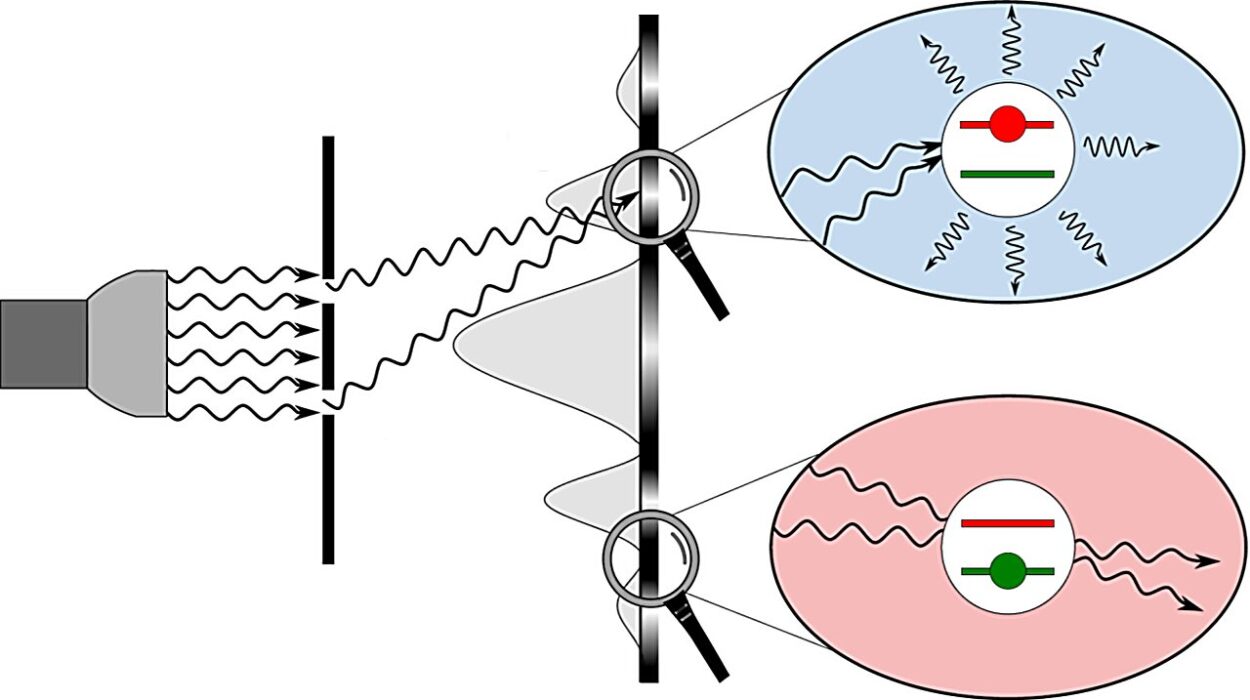Imagine being able to catch a glimpse of the fast-moving world of electrons as they travel through a microscope, not just as blurry streaks, but in sharp focus, with their motions and energy shifts captured with incredible precision. This is the reality that a team of researchers at the Max Planck Institute for Multidisciplinary Sciences is beginning to unlock, and it could transform the way we study the smallest particles in nature.
For decades, electron microscopes have been a crucial tool in science, allowing us to peer into the atomic world. But what if we could see even more? What if we could not only observe these particles, but also understand their intricate relationships—how they interact, how their energies shift, and how they influence each other in real time? This is the question that a group of physicists led by Prof. Claus Ropers is now answering with groundbreaking new experiments that could change the future of ultrafast imaging and quantum technologies.
The Mystery of Electron Pairs
In recent years, researchers have been experimenting with ways to better understand how electrons behave in an electron microscope. These efforts have taken a major leap forward, thanks to new experimental tools and the discovery of nanoscale field emitters—tiny metallic tips that release electrons when exposed to powerful electric fields. This breakthrough has allowed physicists to manipulate and study free electrons, those not bound to any material, in ways that were once unimaginable.
Rudolf Haindl, the first author of the study and one of the driving forces behind the research, explains the challenge they faced: “Just two years ago, we discovered that ultrashort electron pulses in an electron microscope exhibit a peculiar ordering in energy, in a way that is very characteristic for the exact number of electrons in the pulse.” In simpler terms, Haindl and his team realized that electrons in these pulses behaved differently depending on how many were present. Two electrons would move in one particular way, while three or four electrons would behave in their own distinct patterns. This discovery, first reported in Nature Physics in 2023, was made possible by the mutual Coulomb repulsion of the electrons as they accelerated in the microscope—a fascinating effect that laid the foundation for their latest work.
The research team’s new study, published in Physical Review Letters, takes this exploration further. Their goal: to investigate the properties of the small, well-defined groups of electrons in these ultrashort pulses and understand how their energy and behavior evolve together over time. Prof. Ropers and his colleagues were keen to answer two key questions: “When precisely does each of the electrons arrive at the sample plane of the microscope, and at what energy?” These questions were not only intriguing from a scientific perspective, but posed a significant experimental challenge—one that they were eager to tackle.
Pushing the Limits of Precision
To answer these questions, the team turned to a clever experimental setup involving a nanometer-thin silicon membrane illuminated by a laser pulse. This membrane allows the electrons to pass through, but when the laser interacts with it, it generates a tiny electromagnetic field at the surface. This field scatters the electrons and, as they pass through, the electrons can absorb or emit photons, which causes slight shifts in their energies.
Dr. Valerio Di Giulio, the scientist who developed the theoretical foundation for the experiment, explains how this works: “Since the number of exchanged quanta depends on the light intensity, by adjusting the timing between the laser and electron pulses, we could determine when the electrons were affected by the light.” In other words, by tweaking the timing of the laser and electron pulses, the researchers could precisely map how and when the electrons’ energies shifted. This allowed them to capture a series of “temporal slices” that provided a window into the evolution of the electrons’ energy and their relationship to one another.
The result of these efforts was a remarkable breakthrough: the team was able to directly map the complete phase-space distribution of pairs of electrons for the first time, revealing how these pairs of electrons evolved together in time and energy. Haindl describes this achievement: “We were able to directly map the complete phase-space distribution of two-electron pulses—revealing, for the first time, how just a few free electrons evolve together in time and energy.”
Understanding Electron Motion
One of the key findings of the research was that when both emitted electrons interacted with the same laser pulse, their scattered energies became directly linked to the oscillations of the laser’s electric field. This relationship allowed the researchers to determine the exact timing of these oscillations simply by selecting the final kinetic energies of the electrons. This innovative approach could have far-reaching consequences for quantum technologies, as Dr. Di Giulio explains: “Our theoretical predictions suggest that this effect can be exploited to coherently control the excitation phase and probability of quantum systems.”
The team’s work revealed that the longitudinal phase space of emitted electron pairs had a bimodal structure, meaning it exhibited two distinct patterns. One of these patterns was a result of the repulsion between the two electrons, while the other came from their dispersion. In a subtle twist, the researchers also considered whether these electron pairs might be entangled, but found that the correlations they observed had a classical—rather than quantum—origin. This distinction is important because it suggests that, while they weren’t dealing with quantum entanglement, their findings still represent an important step in understanding and manipulating electron behavior.
The Road Ahead: Engineering Electron States
Looking forward, Haindl and his team are excited about the possibilities that this new understanding of electron behavior opens up. Their next steps involve pushing the boundaries of what’s possible with ultrafast electron pulses. “We plan to explore the coherent shaping of few-electron pulses in greater detail—pushing toward regimes where the motion of one electron can actively influence that of another in a controlled manner,” says Prof. Ropers.
Ultimately, the team hopes to leverage this new knowledge to develop even more precise and powerful electron microscopes. Their long-term vision is to use tailored few-electron pulses to probe dynamic processes at the nanoscale with unprecedented temporal resolution—offering scientists a powerful new tool for studying everything from biological processes to material science.
Why This Research Matters
At first glance, the study of electron pulses may seem like an esoteric pursuit with limited real-world applications. However, the implications of this research are far-reaching. By unlocking the secrets of how electrons behave when they are free from the confines of matter, researchers could pave the way for ultrafast imaging systems with remarkable temporal resolution. These systems could revolutionize our ability to study processes that happen on timescales too short for traditional methods, such as chemical reactions or the dynamics of proteins.
Moreover, the insights gained from this research could have profound implications for the development of quantum technologies. By understanding how electrons interact and evolve in time and energy, scientists may soon be able to design quantum systems with unprecedented control, opening new possibilities for everything from quantum computing to secure communication networks.
In the end, this study marks an exciting step forward in our ability to observe and manipulate the microscopic world. As we continue to push the boundaries of technology and our understanding of the quantum realm, experiments like these will play a crucial role in shaping the future of science and technology for generations to come.
More information: Rudolf Haindl et al, Femtosecond and Attosecond Phase-Space Correlations in Few-Particle Photoelectron Pulses, Physical Review Letters (2025). DOI: 10.1103/lylq-m63c. journals.aps.org/prl/abstract/10.1103/lylq-m63c






